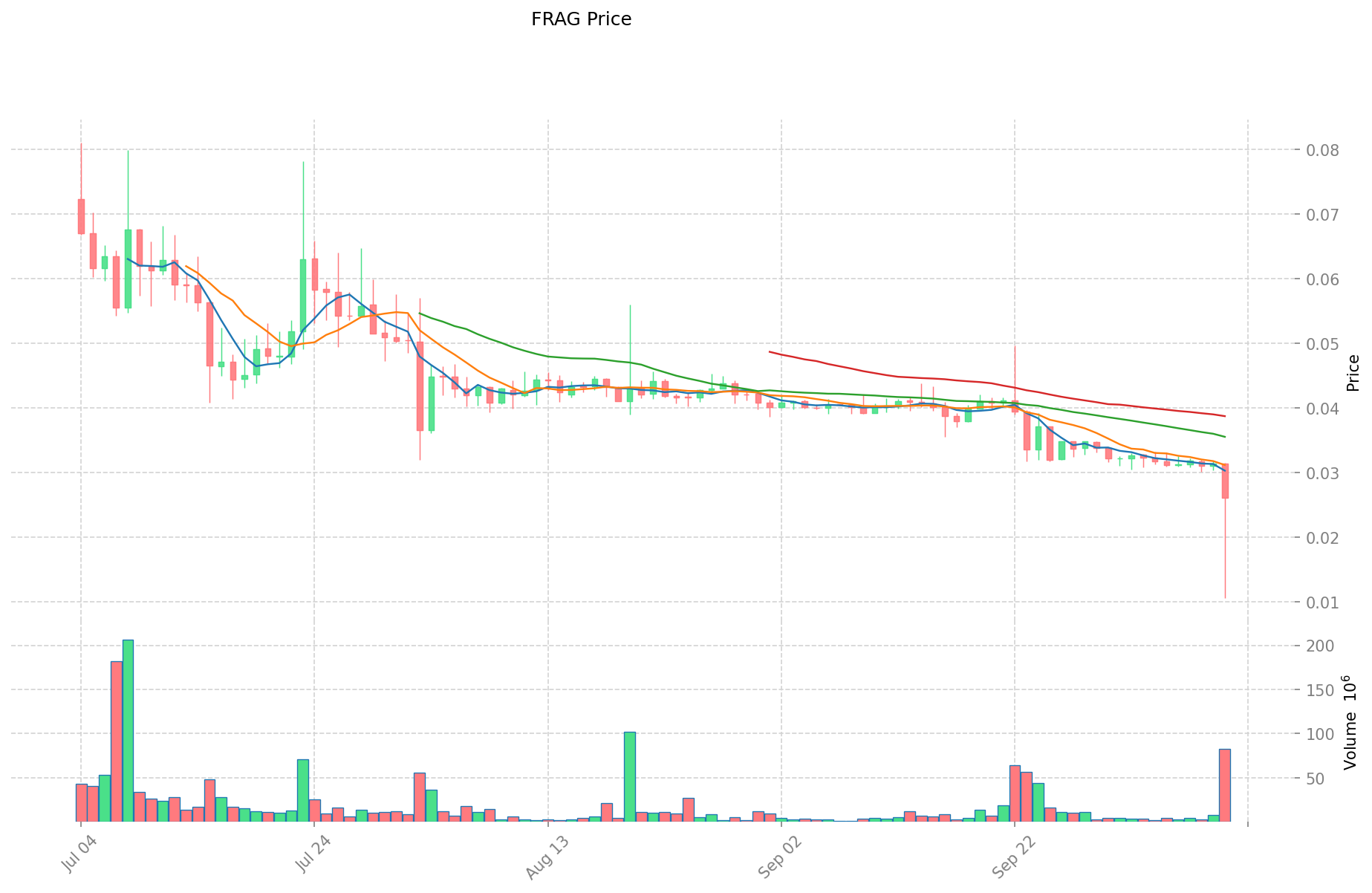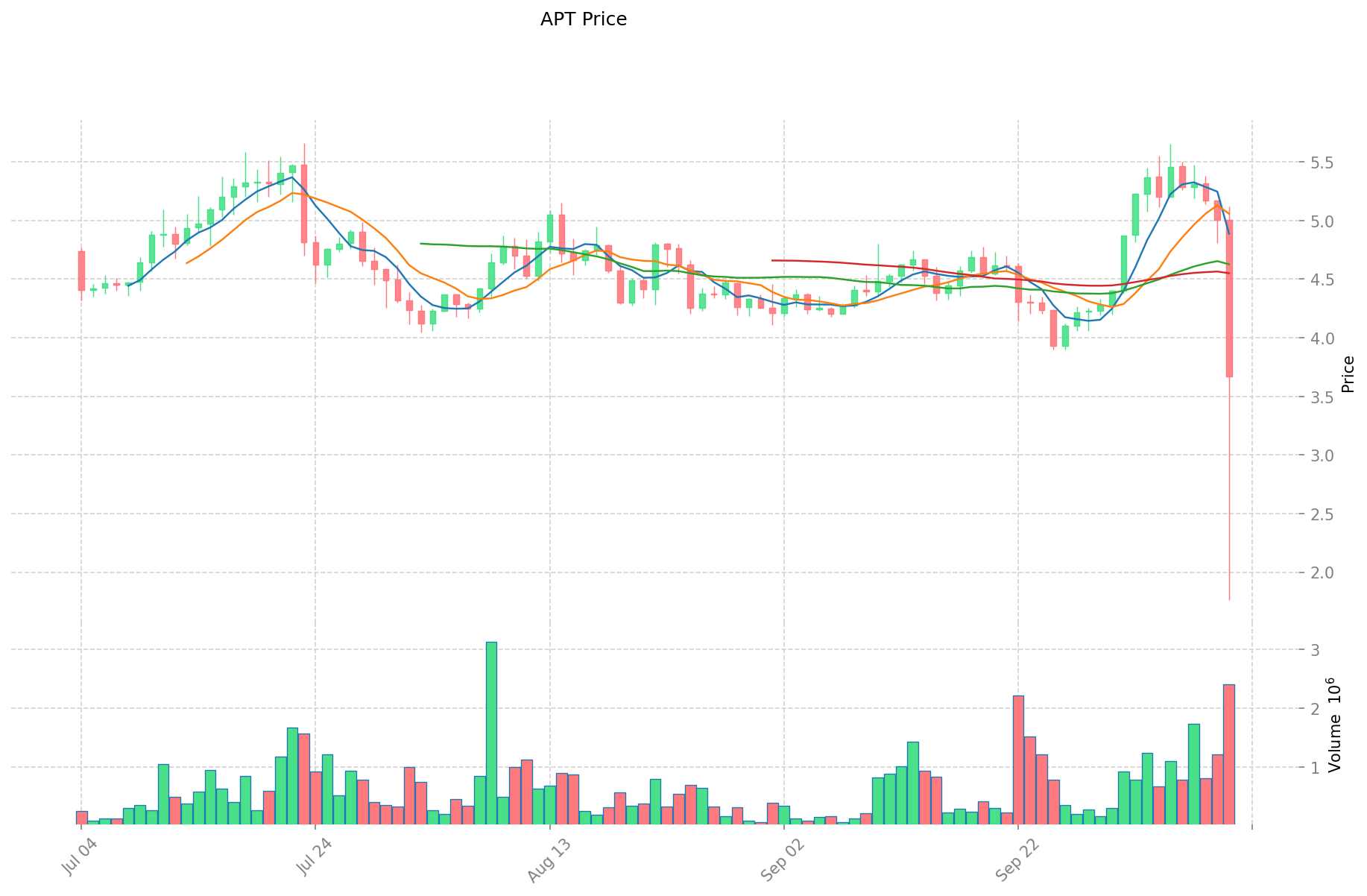FRAG vs APT: Comparing Two Cybersecurity Threat Models in Modern Digital Warfare
Introduction: FRAG vs APT Investment Comparison
In the cryptocurrency market, the comparison between FRAG and APT has been an unavoidable topic for investors. The two not only show significant differences in market cap ranking, application scenarios, and price performance, but also represent different positioning in the crypto asset space.
Fragmetric (FRAG): Since its launch, it has gained market recognition for its advanced FRAG-22 asset management standard on the Solana blockchain.
Aptos (APT): Introduced as a high-performance PoS Layer 1 project, it aims to deliver a secure and scalable blockchain solution.
This article will comprehensively analyze the investment value comparison between FRAG and APT, focusing on historical price trends, supply mechanisms, institutional adoption, technological ecosystems, and future predictions, attempting to answer the question most crucial to investors:
"Which is the better buy right now?"
I. Price History Comparison and Current Market Status
FRAG (Coin A) and APT (Coin B) Historical Price Trends
- 2025: FRAG reached its all-time high of $0.189 on July 1st, likely due to increased adoption or a major partnership announcement.
- 2025: APT experienced significant volatility, reaching an all-time low of $2.8 on October 10th, possibly influenced by broader market conditions or project-specific developments.
- Comparative analysis: In the recent market cycle, FRAG dropped from its peak of $0.189 to a low of $0.01055, while APT showed more resilience, maintaining a higher price range despite market turbulence.
Current Market Situation (2025-10-11)
- FRAG current price: $0.02619
- APT current price: $3.645
- 24-hour trading volume: $1,695,061 (FRAG) vs $10,393,648 (APT)
- Market Sentiment Index (Fear & Greed Index): 27 (Fear)
Click to view real-time prices:
- Check FRAG current price Market Price
- Check APT current price Market Price


II. Core Factors Affecting the Investment Value of FRAG vs APT
Supply Mechanism Comparison (Tokenomics)
- FRAG: High-risk investment with value largely driven by market speculation
- APT: High-risk investment requiring careful evaluation of market trends
- 📌 Historical pattern: Supply mechanisms typically create volatility cycles requiring careful risk assessment
Institutional Adoption and Market Applications
- Institutional holdings: Limited information available on institutional preference
- Enterprise adoption: Both assets demonstrate high-risk characteristics requiring thorough evaluation of market demand
- Regulatory stance: Varying regulatory frameworks across jurisdictions impact investment security
Technical Development and Ecosystem Building
- Technical innovation: An essential factor in determining long-term value for both assets
- Market demand: Sustainability depends on practical applications and adoption
- Ecosystem comparison: Both exist in volatile environments where scarcity may be diluted over time
Macroeconomic and Market Cycles
- Performance during inflation: Insufficient data on inflation-resistant properties
- Macroeconomic monetary policy: High-risk nature suggests vulnerability to broader economic conditions
- Geopolitical factors: Regulatory developments across different regions remain a critical consideration
III. 2025-2030 Price Prediction: FRAG vs APT
Short-term Forecast (2025)
- FRAG: Conservative $0.015399 - $0.0261 | Optimistic $0.0261 - $0.038628
- APT: Conservative $1.911 - $3.675 | Optimistic $3.675 - $4.557
Mid-term Forecast (2027)
- FRAG may enter a growth phase, with an estimated price range of $0.0374386752 - $0.0452383992
- APT may enter a growth phase, with an estimated price range of $3.3487776 - $6.278958
- Key drivers: Institutional capital inflow, ETF, ecosystem development
Long-term Forecast (2030)
- FRAG: Base scenario $0.05669783169804 - $0.072573224573491 | Optimistic scenario $0.072573224573491+
- APT: Base scenario $6.8760869058 - $7.976260810728 | Optimistic scenario $7.976260810728+
Disclaimer: The information provided is for informational purposes only and should not be considered as financial advice. Cryptocurrency markets are highly volatile and unpredictable. Always conduct your own research before making any investment decisions.
FRAG:
| 年份 | 预测最高价 | 预测平均价格 | 预测最低价 | 涨跌幅 |
|---|---|---|---|---|
| 2025 | 0.038628 | 0.0261 | 0.015399 | 0 |
| 2026 | 0.04563324 | 0.032364 | 0.03009852 | 23 |
| 2027 | 0.0452383992 | 0.03899862 | 0.0374386752 | 48 |
| 2028 | 0.049699841328 | 0.0421185096 | 0.024428735568 | 60 |
| 2029 | 0.06748648793208 | 0.045909175464 | 0.03626824861656 | 75 |
| 2030 | 0.072573224573491 | 0.05669783169804 | 0.030049850799961 | 116 |
APT:
| 年份 | 预测最高价 | 预测平均价格 | 预测最低价 | 涨跌幅 |
|---|---|---|---|---|
| 2025 | 4.557 | 3.675 | 1.911 | 0 |
| 2026 | 5.18616 | 4.116 | 2.4696 | 12 |
| 2027 | 6.278958 | 4.65108 | 3.3487776 | 27 |
| 2028 | 6.33942204 | 5.465019 | 5.08246767 | 49 |
| 2029 | 7.8499532916 | 5.90222052 | 3.6003545172 | 61 |
| 2030 | 7.976260810728 | 6.8760869058 | 4.950782572176 | 88 |
IV. Investment Strategy Comparison: FRAG vs APT
Long-term vs Short-term Investment Strategy
- FRAG: Suitable for investors focused on asset management innovations and Solana ecosystem potential
- APT: Suitable for investors interested in high-performance Layer 1 solutions and scalability
Risk Management and Asset Allocation
- Conservative investors: FRAG: 20% vs APT: 80%
- Aggressive investors: FRAG: 40% vs APT: 60%
- Hedging tools: Stablecoin allocation, options, cross-currency portfolios
V. Potential Risk Comparison
Market Risk
- FRAG: Higher volatility, potentially lower liquidity
- APT: Susceptible to broader Layer 1 competition and market trends
Technical Risk
- FRAG: Scalability, network stability on Solana
- APT: Centralization concerns, potential security vulnerabilities
Regulatory Risk
- Global regulatory policies may impact both, with varying effects based on jurisdictional approach
VI. Conclusion: Which Is the Better Buy?
📌 Investment Value Summary:
- FRAG advantages: Innovative asset management standard, Solana ecosystem integration
- APT advantages: High-performance Layer 1 solution, potential for scalability and security
✅ Investment Advice:
- New investors: Consider a balanced approach with a slight preference for APT due to its more established market position
- Experienced investors: Evaluate based on risk tolerance and belief in respective technological propositions
- Institutional investors: Conduct thorough due diligence on both projects, considering APT for larger allocations due to higher market cap and liquidity
⚠️ Risk Warning: Cryptocurrency markets are highly volatile. This article does not constitute investment advice. None
VII. FAQ
Q1: What are the key differences between FRAG and APT? A: FRAG is an asset management token on Solana focusing on the FRAG-22 standard, while APT is a high-performance Layer 1 blockchain project aiming for security and scalability.
Q2: Which coin has shown better price performance recently? A: APT has shown more price resilience, maintaining a higher price range despite market turbulence, while FRAG experienced a significant drop from its all-time high.
Q3: How do the supply mechanisms of FRAG and APT compare? A: Both FRAG and APT are considered high-risk investments. Their supply mechanisms typically create volatility cycles that require careful risk assessment.
Q4: What are the long-term price predictions for FRAG and APT by 2030? A: For FRAG, the base scenario predicts $0.05669783169804 - $0.072573224573491. For APT, the base scenario predicts $6.8760869058 - $7.976260810728.
Q5: How should investors allocate their portfolio between FRAG and APT? A: Conservative investors might consider 20% FRAG and 80% APT, while aggressive investors might opt for 40% FRAG and 60% APT.
Q6: What are the main risks associated with investing in FRAG and APT? A: Key risks include market volatility, technical challenges (scalability for FRAG, centralization for APT), and regulatory uncertainties affecting both tokens.
Q7: Which coin is recommended for new investors? A: New investors might consider a balanced approach with a slight preference for APT due to its more established market position and higher liquidity.
Share
Content